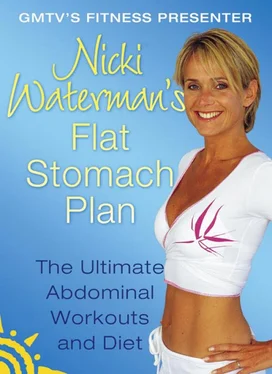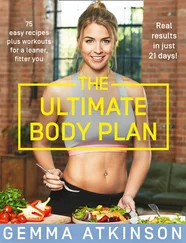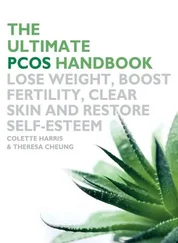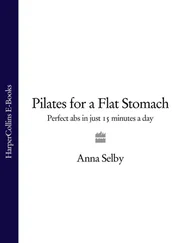Nicki Waterman’s
Flat Stomach Plan
The Ultimate Abdominal
Workouts and Diet

Cover
Title Page Nicki Waterman’s Flat Stomach Plan The Ultimate Abdominal Workouts and Diet
Introduction Introduction So you want to have a nice flat tum? Well who doesn’t? If you want to look in the mirror and see a tummy you would be proud to show, then the best way of going about it is to do the ‘curl’. Of course, curls on their own aren’t a magic bullet to a wonderful new you. A firm tummy buried beneath a thick layer of fat will still protrude and look flabby. If you do the curl three or four times a week and don’t tackle the problem by any other means then, yes, you will still tone up your tummy (as well as improve your posture and help prevent backache). However, to really flatten your stomach and see the pounds drop off you need to take three steps: 1. Do the curl three or four times a week. 2. Do an aerobic workout every day. 3. Eat sensibly. If you combine a regular abs session with healthy eating and an overall workout programme that includes aerobic activity, then not only will those pounds drop off, but your body shape will be transformed.
How to Use this Book
Chapter 1
Warming Up
Chapter 2
STAGE 1:
Beginner’s Curls
Chapter 3
STAGE 2:
Intermediate Curls
Chapter 4
STAGE 3:
Difficult Curls
Chapter 5
STAGE 4:
Tough Curls
Chapter 6
Fab Abs Challenge
Chapter 7
Cool Down and Relax
Chapter 8
Preventing Back Problems
Chapter 9
Exercise and Pregnancy
Chapter 10
The Curl-Free Workout
Chapter 11
Tone Your Tum with Belly Dancing
Chapter 12
Diet – A Crucial Part of the Equation
Chapter 13
The Flat Stomach Recipes
Index
Copyright
About the Publisher
So you want to have a nice flat tum? Well who doesn’t? If you want to look in the mirror and see a tummy you would be proud to show, then the best way of going about it is to do the ‘curl’.
Of course, curls on their own aren’t a magic bullet to a wonderful new you. A firm tummy buried beneath a thick layer of fat will still protrude and look flabby. If you do the curl three or four times a week and don’t tackle the problem by any other means then, yes, you will still tone up your tummy (as well as improve your posture and help prevent backache). However, to really flatten your stomach and see the pounds drop off you need to take three steps:
1. Do the curl three or four times a week.
2. Do an aerobic workout every day.
3. Eat sensibly.
If you combine a regular abs session with healthy eating and an overall workout programme that includes aerobic activity, then not only will those pounds drop off, but your body shape will be transformed.
So what exactly is the curl and why will it work for you? In simple terms, the curl is an exercise that tones up the abdomen by tightening and then relaxing the network of muscles of the stomach and waist – muscles known as the abdominals, or abs. And the stronger the abs, the flatter the stomach.
The most effective way of toning up the abs is to shorten the distance between your ribcage and your pelvis by repeatedly contracting the muscles in your abdomen. Sports science has shown that the best and safest way of achieving this is by using your stomach muscles to lift your upper back off the floor towards your middle (curl) and to lift the hips and bring them up towards your chest (reverse curl). The best method of defining the waist is to subject the abdominal muscles that run around the midriff to twists.
Achieving a flat, strong stomach may be your goal for the simple reason that it looks good, but it is desirable for other reasons too. Well-trained abs help to prevent lower back pain, as well as encouraging good posture, a well-aligned body and a general sense of well-being.
Like all the best modern workout programmes, abs training has a lot of sports science behind it. It is carefully devised, well thought-out and safe. And, as I pointed out before, the curl – or ‘the crunch’ as it is also known – is recognized as one of the most effective forms of ab training.
So how does ab training work?
Let’s start with a quick anatomy lesson so that you understand what is going on inside you. The pelvic girdle – the ring of bone that your legs are connected to – is the bowl in which many of your vital organs sit. To keep them in there and to protect them from harm, you need more than your pelvis, backbone and your skin – you need a firm wall of abdominal muscles. These muscles also give you the ability to bend forward and to twist from the waist. (At the back of the body are the back muscles, which, together with your backbone and ribcage, help support your frame and hold you upright. I look at these in more detail in Chapter 8.)
Your abdominal muscles consist of a thick layer – a sheet almost – of overlapping fibres that stretch downwards from your ribcage to your pelvis and wrap sideways around you from your spine to the front of your pelvis, like the interlocking fingers of both hands.
The main muscle is the rectus abdominus, which stretches vertically from the ribs (directly beneath your breasts) to the front of the pelvic girdle. The oblique abdominals start at your spine and wrap, in a forward and downward slant, around your body in two layers (internal and external) to the pelvic girdle. Finally there are the transverse abs, which fan out from the ribs to the pelvis across your lower abdomen.
Forward flexion – bending down
You are able to bend from the waist thanks to the action of the rectus abdominus. This is a very strong and long muscle that appears to be divided in two down a line running between your sternum and navel. In fact, it is one big muscle joined by thin sheets of muscle fibre. (It can, however, separate along this ‘join’ during pregnancy – see Chapter 98 Exercise and Pregnancy.) This is the muscle that is strengthened and toned during forward curls.
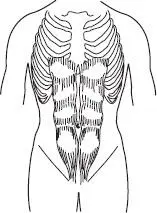
Rotation and forward flexion – bending and twisting
The internal and external obliques not only ensure that we can rotate our torso (for example to turn sideways when driving so we can look behind us) but they also assist in forward flexion. A nice bonus of well-toned obliques is that your waist gets slimmer and more defined. We strengthen and tone these muscles by adding a twist to the basic curl. (Note: whenever you work one side, you should always work the opposite side.)

The transverse abs, which fan out from the middle across the lower half of your abdomen to the sides of your pelvic girdle, do the most work in protecting your internal organs. At the same time, they assist in breathing. The diaphragm is known as the bellows of the lungs, but if you take a deep breath and then exhale you will be able to feel the transverse abs helping to expel the air. It is these muscles that work hard in a basic curl and that make the lower half of your tummy flat.
Читать дальше
